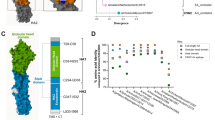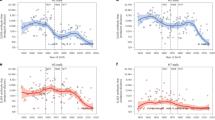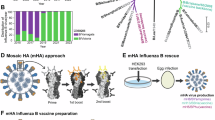Abstract
Neutralizing antibodies that target epitopes conserved among many strains of influenza virus have been recently isolated from humans. Here we demonstrate that adeno-associated viruses (AAV) encoding two such broadly neutralizing antibodies are protective against diverse influenza strains. Serum from mice that received a single intramuscular AAV injection efficiently neutralized all H1, H2 and H5 influenza strains tested. After infection with diverse strains of H1N1 influenza, treated mice showed minimal weight loss and lung inflammation. Protection lasted for at least 11 months after AAV injection. Notably, even immunodeficient and older mice were protected by this method, suggesting that expression of a monoclonal antibody alone is sufficient to protect mice from illness. If translated to humans, this prophylactic approach may be uniquely capable of protecting immunocompromised or elderly patient populations not reliably protected by existing vaccines.
This is a preview of subscription content, access via your institution
Access options
Subscribe to this journal
Receive 12 print issues and online access
$259.00 per year
only $21.58 per issue
Buy this article
- Purchase on SpringerLink
- Instant access to full article PDF
Prices may be subject to local taxes which are calculated during checkout



Similar content being viewed by others
References
Centers for Disease Control and Prevention (CDC). Estimates of deaths associated with seasonal influenza—United States, 1976–2007. MMWR Morb. Mortal. Wkly. Rep. 59, 1057–1062 (2010).
Nair, H. et al. Global burden of respiratory infections due to seasonal influenza in young children: a systematic review and meta-analysis. Lancet 378, 1917–1930 (2011).
Smith, D.J. et al. Mapping the antigenic and genetic evolution of influenza virus. Science 305, 371–376 (2004).
Morens, D.M. & Taubenberger, J.K. Historical thoughts on influenza viral ecosystems, or behold a pale horse, dead dogs, failing fowl, and sick swine. Influenza Other Respir. Viruses 4, 327–337 (2010).
Johnson, N.P.A.S. & Mueller, J. Updating the accounts: global mortality of the 1918–1920 'Spanish' influenza pandemic. Bull. Hist. Med. 76, 105–115 (2002).
Aspinall, R., Del Giudice, G., Effros, R.B., Grubeck-Loebenstein, B. & Sambhara, S. Challenges for vaccination in the elderly. Immun. Ageing 4, 9 (2007).
Goodwin, K., Viboud, C. & Simonsen, L. Antibody response to influenza vaccination in the elderly: a quantitative review. Vaccine 24, 1159–1169 (2006).
Sui, J. et al. Structural and functional bases for broad-spectrum neutralization of avian and human influenza A viruses. Nat. Struct. Mol. Biol. 16, 265–273 (2009).
Ekiert, D.C. et al. Antibody recognition of a highly conserved influenza virus epitope. Science 324, 246–251 (2009).
Throsby, M. et al. Heterosubtypic neutralizing monoclonal antibodies cross-protective against H5N1 and H1N1 recovered from human IgM+ memory B cells. PLoS ONE 3, e3942 (2008).
Wei, C.-J. Induction of broadly neutralizing H1N1 influenza antibodies by vaccination. Science 329, 1060–1064 (2010).
Steel, J. et al. Influenza virus vaccine based on the conserved hemagglutinin stalk domain. mBio 1, e00018–10 (2010).
Clark, T.W. et al. Trial of 2009 influenza A (H1N1) monovalent MF59-adjuvanted vaccine. N. Engl. J. Med. 361, 2424–2435 (2009).
Balazs, A.B. et al. Antibody-based protection against HIV infection by vectored immunoprophylaxis. Nature 481, 81–84 (2011).
Johnson, P.R. et al. Vector-mediated gene transfer engenders long-lived neutralizing activity and protection against SIV infection in monkeys. Nat. Med. 15, 901–906 (2009).
Bloom, J.D., Gong, L.I. & Baltimore, D. Permissive secondary mutations enable the evolution of influenza oseltamivir resistance. Science 328, 1272–1275 (2010).
Hancock, K. et al. Cross-reactive antibody responses to the 2009 pandemic H1N1 influenza virus. N. Engl. J. Med. 361, 1945–1952 (2009).
Shultz, L.D. et al. Human lymphoid and myeloid cell development in NOD/LtSz-scid IL2R gamma null mice engrafted with mobilized human hemopoietic stem cells. J. Immunol. 174, 6477–6489 (2005).
Enserink, M. Infectious diseases. Controversial studies give a deadly flu virus wings. Science 334, 1192–1193 (2011).
Collin, N. & de Radiguès, X. World Health Organization H1N1 Vaccine Task Force Vaccine production capacity for seasonal and pandemic (H1N1) 2009 influenza. Vaccine 27, 5184–5186 (2009).
Li, Y. et al. Continued evolution of H5N1 influenza viruses in wild birds, domestic poultry, and humans in China from 2004 to 2009. J. Virol. 84, 8389–8397 (2010).
Croyle, M.A., Cheng, X. & Wilson, J.M. Development of formulations that enhance physical stability of viral vectors for gene therapy. Gene Ther. 8, 1281–1290 (2001).
Corti, D. et al. A neutralizing antibody selected from plasma cells that binds to group 1 and group 2 influenza A hemagglutinins. Science 333, 850–856 (2011).
Marsh, G.A., Hatami, R. & Palese, P. Specific residues of the influenza A virus hemagglutinin viral RNA are important for efficient packaging into budding virions. J. Virol. 81, 9727–9736 (2007).
Krause, J.C. et al. A broadly neutralizing human monoclonal antibody that recognizes a conserved, novel epitope on the globular head of the influenza H1N1 virus hemagglutinin. J. Virol. 85, 10905–10908 (2011).
Dreyfus, C. et al. Highly conserved protective epitopes on influenza B viruses. Science 337, 1343–1348 (2012).
Anonymous. Recommendations of the Advisory Committee on Immunization Practices (ACIP): use of vaccines and immune globulins for persons with altered immunocompetence. MMWR Recomm. Rep. 42, 1–18 (1993).
Nathwani, A.C. et al. Adenovirus-associated virus vector–mediated gene transfer in hemophilia B. N. Engl. J. Med. 365, 2357–2365 (2011).
Hoffmann, E., Neumann, G., Kawaoka, Y., Hobom, G. & Webster, R.G.A. DNA transfection system for generation of influenza A virus from eight plasmids. Proc. Natl. Acad. Sci. USA 97, 6108–6113 (2000).
Matrosovich, M., Matrosovich, T., Garten, W. & Klenk, H.-D. New low-viscosity overlay medium for viral plaque assays. Virol. J. 3, 63 (2006).
Acknowledgements
The authors wish to thank D. Majumdar, A. Sigal and J. Zhao for their helpful comments, and other members of the Baltimore Lab for their assistance in carrying out this work. This project was supported by a contract from the National Institute of Allergy and Infectious Disease (NIAID) and by the Joint Center for Translational Medicine as well as a Caltech Translational Innovation Partnership Award. A.B.B. is supported by the amfAR postdoctoral research fellowship no. 107756-47-RFVA. D.S.R. is supported by career development award 1K08CA133521 from the National Institutes of Health. The bidirectional reverse-genetics plasmids29 from the PR/34 strain of influenza were a kind gift from R. Webby of St. Jude Children's Research Hospital. The pHW2000 plasmid was a kind gift from Y. Kawaoka of the University of Wisconsin.
Author information
Authors and Affiliations
Contributions
A.B.B. conceived the study, designed and performed experiments, and wrote the manuscript. J.D.B. conceived the study and designed experiments, C.M.H. performed experiments, D.S.R. performed histological analysis, and D.B. conceived the study and wrote the manuscript.
Corresponding author
Ethics declarations
Competing interests
The authors declare no competing financial interests.
Supplementary information
Rights and permissions
About this article
Cite this article
Balazs, A., Bloom, J., Hong, C. et al. Broad protection against influenza infection by vectored immunoprophylaxis in mice. Nat Biotechnol 31, 647–652 (2013). https://doi.org/10.1038/nbt.2618
Received:
Accepted:
Published:
Issue date:
DOI: https://doi.org/10.1038/nbt.2618
This article is cited by
-
Administration of an AAV vector coding for a P2X7-blocking nanobody-based biologic ameliorates colitis in mice
Journal of Nanobiotechnology (2024)
-
AAV-vectored expression of monospecific or bispecific monoclonal antibodies protects mice from lethal Pseudomonas aeruginosa pneumonia
Gene Therapy (2024)
-
Adeno-associated virus mediated expression of monoclonal antibody MR191 protects mice against Marburg virus and provides long-term expression in sheep
Gene Therapy (2022)
-
A llama-derived antibody for flu
Nature Biotechnology (2019)
-
mRNA as novel technology for passive immunotherapy
Cellular and Molecular Life Sciences (2019)



